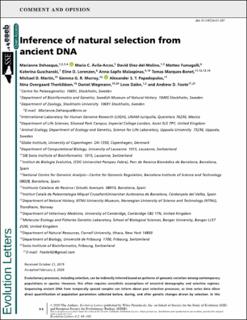| dc.contributor.author | Dehasque, Marianne | |
| dc.contributor.author | Ávila-Arcos, María C | |
| dc.contributor.author | Díez-del-Molino, David | |
| dc.contributor.author | Fumagalli, Matteo | |
| dc.contributor.author | Guschanski, Katerina | |
| dc.contributor.author | Lorenzen, Eline D. | |
| dc.contributor.author | Malaspinas, Anna-Sapfo | |
| dc.contributor.author | Marques-Bonet, Tomas | |
| dc.contributor.author | Martin, Michael David | |
| dc.contributor.author | Murray, Gemma G.R. | |
| dc.contributor.author | Papadopulos, Alexander | |
| dc.contributor.author | Therkildsen, Nina Overgaard | |
| dc.contributor.author | Wegmann, Daniel | |
| dc.contributor.author | Dalén, Love | |
| dc.contributor.author | Foote, Andrew | |
| dc.date.accessioned | 2021-03-02T14:40:34Z | |
| dc.date.available | 2021-03-02T14:40:34Z | |
| dc.date.created | 2021-01-20T14:44:29Z | |
| dc.date.issued | 2020 | |
| dc.identifier.citation | Evolution Letters. 2020, 4 (2), 94-108. | en_US |
| dc.identifier.issn | 2056-3744 | |
| dc.identifier.uri | https://hdl.handle.net/11250/2731221 | |
| dc.description.abstract | Evolutionary processes, including selection, can be indirectly inferred based on patterns of genomic variation among contemporary populations or species. However, this often requires unrealistic assumptions of ancestral demography and selective regimes. Sequencing ancient DNA from temporally spaced samples can inform about past selection processes, as time series data allow direct quantification of population parameters collected before, during, and after genetic changes driven by selection. In this Comment and Opinion, we advocate for the inclusion of temporal sampling and the generation of paleogenomic datasets in evolutionary biology, and highlight some of the recent advances that have yet to be broadly applied by evolutionary biologists. In doing so, we consider the expected signatures of balancing, purifying, and positive selection in time series data, and detail how this can advance our understanding of the chronology and tempo of genomic change driven by selection. However, we also recognize the limitations of such data, which can suffer from postmortem damage, fragmentation, low coverage, and typically low sample size. We therefore highlight the many assumptions and considerations associated with analyzing paleogenomic data and the assumptions associated with analytical methods. | en_US |
| dc.language.iso | eng | en_US |
| dc.publisher | Wiley Periodicals, Inc. on behalf of Society for the Study of Evolution (SSE) and European Society for Evolutionary Biology (ESEB). | en_US |
| dc.rights | Navngivelse 4.0 Internasjonal | * |
| dc.rights.uri | http://creativecommons.org/licenses/by/4.0/deed.no | * |
| dc.title | Inference of natural selection from ancient DNA | en_US |
| dc.type | Peer reviewed | en_US |
| dc.type | Journal article | en_US |
| dc.description.version | publishedVersion | en_US |
| dc.source.pagenumber | 94-108 | en_US |
| dc.source.volume | 4 | en_US |
| dc.source.journal | Evolution Letters | en_US |
| dc.source.issue | 2 | en_US |
| dc.identifier.doi | https://doi.org/10.1002/evl3.165 | |
| dc.identifier.cristin | 1875655 | |
| dc.description.localcode | This is an open access article under the terms of the Creative Commons Attribution License, which permits use, distribution and reproduction in any medium, provided the original work is properly cited. | en_US |
| cristin.ispublished | true | |
| cristin.fulltext | original | |
| cristin.qualitycode | 1 | |

